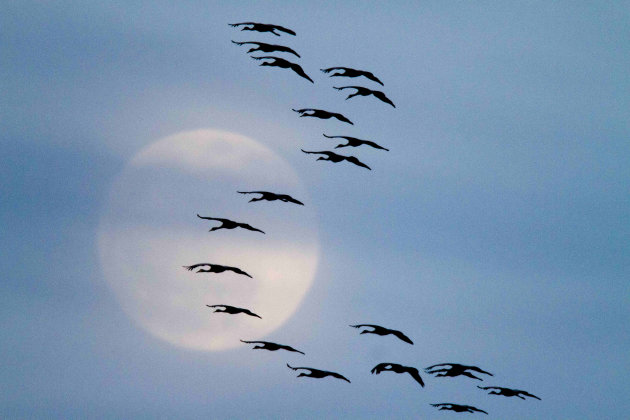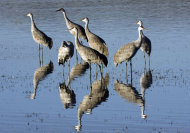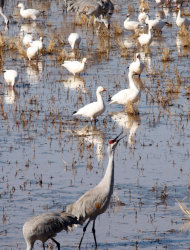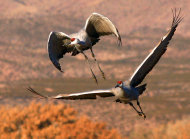It's "Winged Wednesday" Again:
Unbelievable Singing Parrot
__________________
Parenthood, Part 4 and last installment.
"Looked at as a whole, however, birds are not a lot more virtuous or dutiful in their home-making then humans. For example, it has long been thought that birds were the animal kingdom's best representatives of the romantic virtues. The courtship of birds, and their apparent togetherness, has inspired poets, songsmiths and advertising copywriters. We assumed birds don't cheat. Well, they do!
Birds find it pays to deceive their partner as they seek to gain the edge over others of their species, and ensure that their chicks grown to maturity and carry on the lineage.
Although around 90 per cent of bird species form a parental pair, at least for a given breeding season - a higher figure than among other creatures - there is more deception than was ever suspected. Monogamy is not an instinct, hard-wired into animals' brains, as was thought. Even birds considered as paragons of fidelity will indulge in a fling if the situation permits.
The notion of settled married bliss has been blown away by the new technology of DNA fingerprinting, which has revealed that as many as a fifth of the eggs produced by female birds believed to be monogamous had not, after all, been sired by their regular partners.
Scientists now know that many females two-time; that they even practice divorce. There is jealously; there are "home-wreckers."
Jealous female warblers competing for the attention of a male have been caught smashing their rivals' eggs by biologists in Sweden, in this fascinating experiment. The male great reed warbler may have several females nesting in its territory, but only the lucky "primary" female whose eggs hatch first get his help in rearing her young.
Staffan Bensch and his colleagues at Lund University in Sweden placed lifelike plasticine eggs in nests kept from previous years. Newly arrived females, thinking the nests belonged to primary females, pecked holes in the plasticine eggs. However they left the incriminating outline of their beak.
The team was able to show that the pecks of jealous female warblers accounted for one-third of all egg attacks, with predators of other species accounting for the rest.
Professor Nick Davies at Cambridge University discovered quite unexpected infidelity in the humble dunnnock, a small, retiring sparrow-like bird found in British gardens, and previously thought to be a model of marital probity.
Davies and his colleagues used DNA fingerprinting to prove that female dunnocks had been unchaste - there was clear DNA evidence that the chicks in a single nest had different fathers.
The female dunnock may be a busy two-timer. However the superb fairy wren of Southern Australia is the most promiscuous bird in the world. Both males and females have multiple partners.
Scientists conclude that what the sexes seem to be doing is widening their options, indulging in extra-marital liaisons to increase their chances of breeding successfully.
Researchers are now finding that "divorce" is common, even among birds that were thought to pair for life, like swans. Andre Dhondt of Cornell University studied pairs of Belgian great tits, and found that not only do females often instigate divorce, but they usually benefit from it by subsequently producing more offspring. (Failure to rear offspring is a common cause of avian divorce.)
Lewis Oring of the University of Nevada, Reno, studies the killdeer, a North American plover. He has found "home-wreckers"--individuals that break into the relationship drive out their rival and pair with its mate.
Some males act as a "hired gun" to protect females from predators or males that would kill their young. Steve Emlen at Cornell University contends that female bee-eaters form pair bonds with additional males to reduce the levels of harassment from the many males that hang around their communal nest sites.
In time all birds must leave the nest - provided they have survived the many dangers of home life. There is a great deal of variation in how independent the young are once they hatch from the egg. Among most perching birds, seabirds and birds of prey, the chicks hatch after fairly short periods of incubation and need to be fed for a long time.
In other species, such as geese, swans, ducks and waders, the young develop for a long time within the egg and are fully feathered and ready to run about and feed by themselves almost as soon as they leave the egg. Some can even fly.
The chick that is perhaps the most independent at birth is the ancient murrelet, which is taken to sea almost as soon as it is born. It responds to its parents urgent calls when it can neither fly nor feed on its own.
But one young bird has virtually dispensed with the need to be looked after. In Argentina the cuckoo duck egg is dumped by its mother in the nest of an unsuspecting brown hooded gull. Then, after just one day, it ups and leaves the nest to fend for itself. Surely, it is the most self-sufficient bird on earth. "
From: http://www.pbs.org/lifeofbirds/home/index.html
________________
Drought leaves slim pickings for migrating birds
In this Nov. 23, 2009 file photo, a sandhill crane calls out.
ALBUQUERQUE, N.M. (AP) — "From nesting grounds in Alaska and Idaho to the prairie potholes in Canada, thousands of sandhill cranes, snow geese and other migratory birds are making their way south to their traditional winter watering holes in the American Southwest.
The problem is a year of drought has ravaged wetlands and crops throughout Texas and New Mexico, forcing the birds to fly off course in search of water and food.
In the Texas Panhandle, there's no standing water in any of the playas and officials at Buffalo Lake National Wildlife Refuge haven't seen many birds. It's just as dry at Texas' oldest national refuge in Muleshoe, where 27,000 birds have moved through so far this fall.
"I don't know where our birds are going," said refuge manager Jude Smith. "It's not just the cranes, but the geese and the ducks. They had bumper crop years up in the potholes with lots of reproduction but there's nowhere for them to go."
That's why managers at Bosque del Apache National Wildlife Refuge in south-central New Mexico are bracing for record numbers this fall and winter. With nearly 13,000 acres of wetlands, the refuge is one of the country's most well-known spots for observing migrating waterfowl. Thousands of people were expected to visit this week for the annual Festival of the Cranes.
The shallow ponds at Bosque del Apache and the adjacent Rio Grande shine like beacons as the weary birds look for a place to rest after their long journey.
"The birds will go where the water is first and where the food is second. They'll follow those two all the way south," said Jose Viramontes, a spokesman for the U.S. Fish and Wildlife Service.
Bosque del Apache is managed specifically to provide habitat and protection for migrating birds and other endangered species. When farmers upstream finish irrigating for the season, water from the Rio Grande fills the refuge's impoundments, providing a place where birds can roost overnight without having to worry about coyotes or other predators.
But Bosque del Apache wasn't completely immune from the effects of the drought. This year's corn crop that managers depend on to feed the birds throughout the winter was decimated by a lack of rain.
To keep the birds fed, the refuge plans to spread 500,000 pounds of barley donated by a Colorado brewer."
More at: http://news.yahoo.com/drought-leaves-slim-pickings-migrating-birds-141043101.html
__________________
Over one million acres of rainforest saved in Peru, thanks to you!:
"This May marked 11 years of conservation at The Rainforest Site! Thank you for continuing to be an online activist by clicking daily on the green button and shopping in our do-good store. The actions you take help preserve precious habitats around the world. Here is just one of the success stories (from our partner, the Rainforest Conservation Fund) we've been able to achieve together:

Thanks to the support of GreaterGood.org and The Rainforest Site, the Reserva Comunal Tamshiyacu-Tahuayo in Peru, expanded in size from the 322,500 hectares to 422,080 hectares, making it over one million US acres this year. The reserve recently was renamed as the “Área de Conservación Regional Comunal Tamshiyacu-Tahuayo “(ACRCTT).
Today the reserve is home to fourteen species of primates, the highest primate diversity for any protected area in the Amazon, as well as such creatures as the threatened giant anteater also lives within the preserve.
The 180,000 hectare buffer zone that surrounds the reserve is home to RCF community work. Beginning in 2010, RCF began work on restoring on aguaje palm swamps (Mauritia flexuosa) that had been damaged from the cutting of fruit-producing palms and had been invaded by other vegetation with local approval for this long-term project.

Extensive restoration work through the planting of young palms and the removal of invasive vegetation has been carried out since June of 2010 and will continue as funding permits. These palm swamps also serve as a research laboratory and a training area for community conservation leaders.
The sale of the fruits from this huge palm provides income for villagers, and allows them to leave wild palms inside the reserve untouched to produce fruits for the animals.
 There is an enormous diversity of plants and other species in the RCF agroforestry systems and the trees are home to many exotic creatures, such as giant caterpillars (shown left), and birds.
There is an enormous diversity of plants and other species in the RCF agroforestry systems and the trees are home to many exotic creatures, such as giant caterpillars (shown left), and birds.
Some of the institutions that have recently used the facility for conservation, education and community support include: El Comité de Gestión de la ACRCTT, Centro de Salud – Esperanza, Federación de Comunidades Nativas Maijuna (FECONAMAI), Programa de Conservación, Gestión y Uso Sostenible de la Diversidad Biológica en la Región Loreto (PROCREL), The Wildlife Conservation Society (WCS), University of Berkeley Haas Business School, George Mason University, and the San Diego Zoo."
And, please continue clicking and shopping for the cause:
What you do makes a difference.
______________
High-profile expert on exotic birds is sentenced for smuggling parrots
"On Nov 18, 1996, Tony Silva, a world-renowned expert and outspoken protector of exotic birds, is sentenced to seven years in prison without parole for leading an illegal parrot smuggling operation. Silva was only one of many to be arrested during "Operation Renegade," a three-year international probe into bird smuggling by the U.S. Fish and Wildlife Service's Division of Law Enforcement, although his case was by far the best known.
Silva's indictment and guilty plea shocked the international community of academic experts, conservationists, zoologists, and collectors interested in exotic birds, most of whom had known and respected him as a benevolent bird lover. Since his childhood, Silva had championed the cause of protecting wildlife. His parents, who had emigrated to the U.S. from Cuba when he was a boy, encouraged his love of birds, thinking it was a good way to keep their son out of trouble. Silva began breeding birds at a young age, and, by his 20s, he had already written hundreds of articles and two books on rare parrots and had been named curator of Loro Park, a wildlife sanctuary in the Canary Islands.
However, Silva's image greatly changed when he was accused of smuggling more than 100 hyacinth macaws, valued at almost $1.4 million, as well as hundreds of other exotic birds. Hyacinth macaws are extremely rare, having a wild population numbering between only 2,000 and 5,000. During smuggling operations, many of the birds die.
U.S. District Court Judge Elaine Bucklo, outraged at the inhumane treatment the birds had received at the hands of the smugglers, handed down a uniquely harsh sentence in the Silva case: an 82-month prison term, a $100,000 fine and an order to perform 200 hours of community service during a three-year supervised release program after his prison term.
"The real victims of these crimes, " the judge said, "were the birds themselves and our children and future generations who may never have the opportunity to see any of these rare birds."
Silva later claimed that he was set up and had only been trying to protect the birds. However, many disagree with Silva's interpretation of the events, citing the evidence from his trial, which included photographs of dead parrots, a book detailing his smuggling operations found at his home, and a taped conversation of Silva saying that he had 50 hyacinth macaws for sale."
_______________
Avoid messy clean-up from your visiting avian friends
"Birdwatchers enjoy watching birds. It is easier to watch birds if you lure them to your campsite, though it doesn't rule out a good birding walk.
But when these invited guests start doing their natural elimination processes on your spiffy clean RV, that is pushing their welcome too far.
To avoid messy clean ups from your guests' visits, try flying colorful flags or banners near those areas they like to perch.
You can find temporary flag-holders that attach to nearly any flat surface or make your own (photo).
The waving and fluttering of the flags will discourage birds from using your rig and instead choose a nearby tree or bush to rest--don't worry they won't leave, your hospitality and dining options will keep them nearby." From: http://www.rvquicktips.com/2011/10/avoid-messy-clean-up-from-your-visiting.html
__________________
Yesterday:
Jay and I moved more of the yard sale items around, and made everything a little more rain-proof on the open side of the RVport. Yes, we had some rain during the night before. Some of the boxes got a little damp. The rain had stopped by the time we started working, and it was nice being out there. But even if the rain had continued, we were dry in the RVport and storeroom.
After Dick's comment about taking the junk merchandise to a flea market, I had considered it, but it would all have to be sorted out and packed in boxes for transporting, anyway. There is no way my van could haul it all, so it would take several weekends.
A computer man bought the bath tub that came out of the Westwood Coronado, and looked at my computer too. I had asked him about having more RAM put in it. He seemed to think that it was doing OK without it and adding more wouldn't speed it up much, as it is my connection that is slow.
The weather's high was at 7.00 AM at 73 deg., and went down to 60 in the afternoon. We didn't open the back door to the RVport, as it wasn't as hot or clammy as the previous day.





















1 comment:
So, when is the yard sale going to be open to the public?
Post a Comment